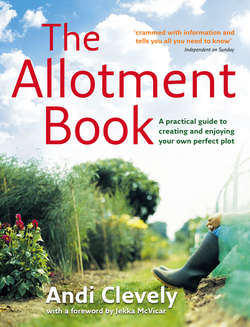Читать книгу The Allotment Book - Andi Clevely - Страница 36
SITE REGULATIONS
ОглавлениеCheck your tenancy agreement before buying or building a shed. Some allotment associations have guidelines on details such as floor, window or door size and structure, appearance, colour, foundations, stability, and distance from the plot boundary. You might need written consent for any deviation from these, even express permission to erect a shed in the first place.
MATERIALS If allowed by your allotment association, a serviceable shed can be built from a host of discarded materials. Traditional materials include doors, window frames, wooden pallets and corrugated iron. On some sites, redundant structures such as railway wagons, upturned boats, sectional concrete garages, even seaside chalets and refreshment kiosks have been used.
Most new sheds are made of pressure-treated or resinous softwood, clad with shiplap, feather-edged or tongue-and-groove weatherboarding, and with a ridged or nearly flat roof protected with felt. Hot-dipped galvanized steel sheds are durable and secure, but unattractive.
FOUNDATIONS Any shed will need a sound, dry foundation. All but the cheapest will be supplied with a floor and instructions for constructing a firm, damp-proof foundation. Site rules often specify how this should be constructed, or give alternative ways to stabilize the structure – for example, sitting the shed on a damp-proof membrane and anchoring it by sinking metal or wooden piles to which it may be fastened.
One reliable method is to remove enough soil over the base area to accommodate a shingle, sand and slab floor. Consolidate the exposed soil firmly, spread a 5cm (2in) deep layer of shingle and firm this in turn. Top with a 2.5cm (1in) layer of sharp sand, then lay paving slabs to finish. Extending this arrangement beyond the floor area would provide a surface for seating and for standing containers or equipment.
An alternative (and also simpler) arrangement is to dig out trenches one-spit deep where the floor bearers rest, fill these with gravel and position the bearers on these: make sure the bearers and the floor are made of treated timber, and that the floor itself sits clear of the ground.
